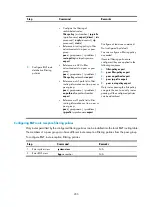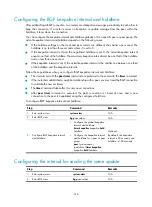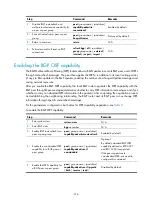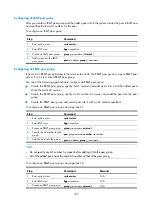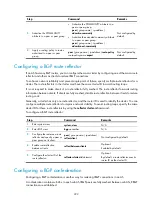
207
Step Command
Remarks
3.
Configure the maximum
number of prefixes allowed to
be received from a peer or
peer group.
•
Specify the maximum number
of prefixes that can be received
from a peer or peer group:
peer
{
group-name
|
ip-address
}
route-limit
prefix-number
[
percentage-value
]
•
Specify the maximum number
of prefixes that can be received
from a peer or peer group:
peer
{
group-name
|
ip-address
}
route-limit
prefix-number
alert-only
[
percentage-value
]
•
Specify the maximum number
of prefixes that can be received
from a peer or peer group:
peer
{
group-name
|
ip-address
}
route-limit
prefix-number
reconnect
reconnect-time
[
percentage-value
]
Use one of the commands.
No limit is configured by default.
I
f the specified maximum number is
reached:
•
For approach 1, the router
breaks down the BGP
connection to the peer.
•
For approach 2, the router
outputs alert information but
does not break down the BGP
connection to the peer.
•
For approach 3, the router
breaks down the BGP
connection to the peer and then
reestablishes a BGP connection
to the peer.
Configuring BGP route dampening
By configuring BGP route dampening, you can suppress unstable routes from being added to the local
routing table or being advertised to BGP peers.
To configure BGP route dampening:
Step Command
Remarks
1.
Enter system view.
system-view
N/A
2.
Enter BGP view.
bgp
as-number
N/A
3.
Configure BGP route
dampening.
dampening
[
half-life-reachable
half-life-unreachable reuse suppress ceiling
|
route-policy
route-policy-name
] *
Not configured by
default.
Configuring a shortcut route
An EBGP route received has a priority of 255, which is lower than a local route. This task allows you to
configure an EBGP route as a shortcut route. It has the same priority as a local route and is more likely
to become the optimal route.
To configure a shortcut route:
Step Command
Remarks
1.
Enter system view.
system-view
N/A
2.
Enter BGP view.
bgp
as-number
N/A













